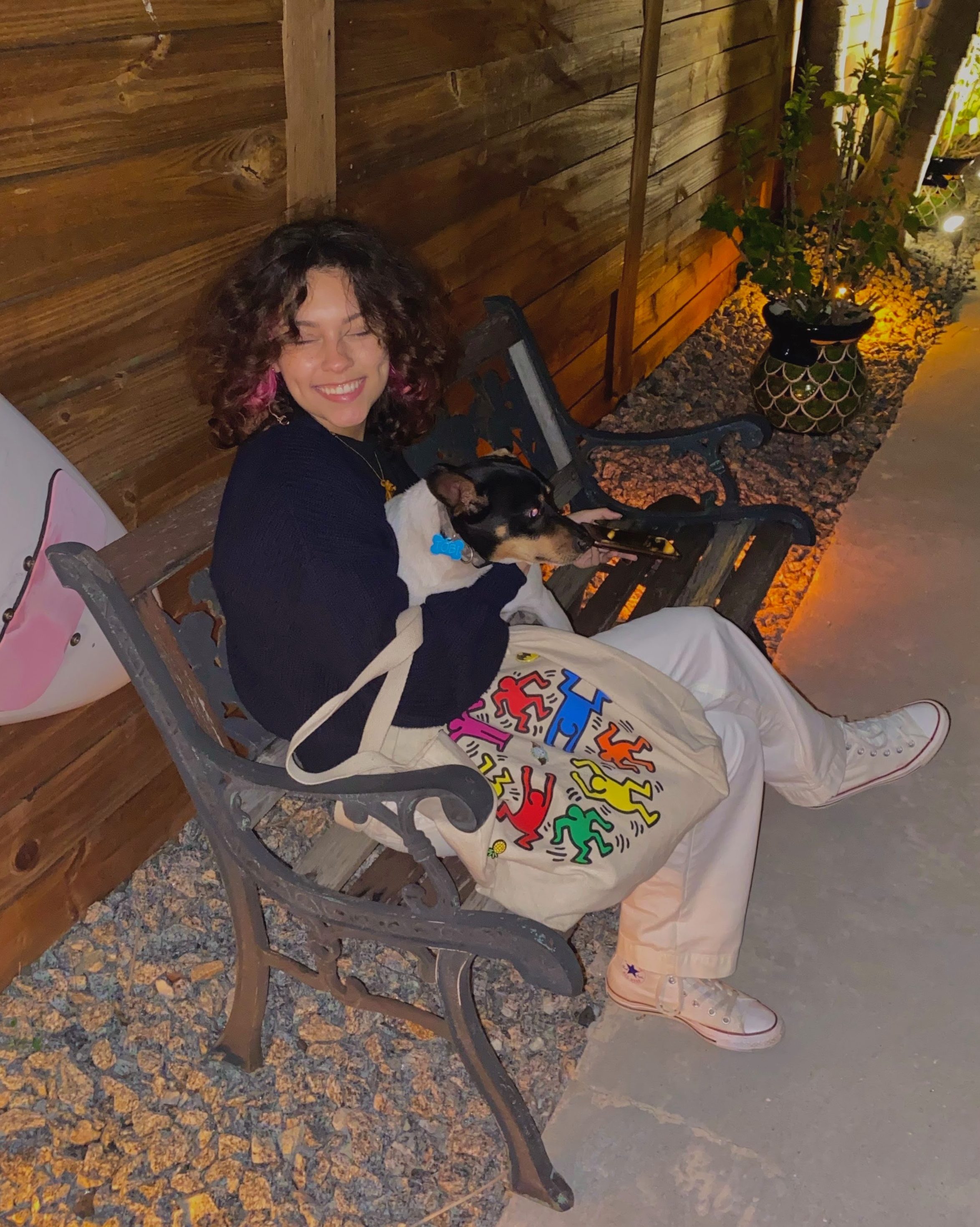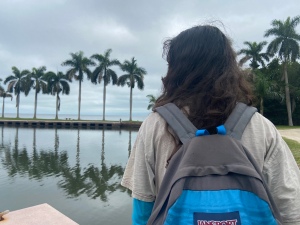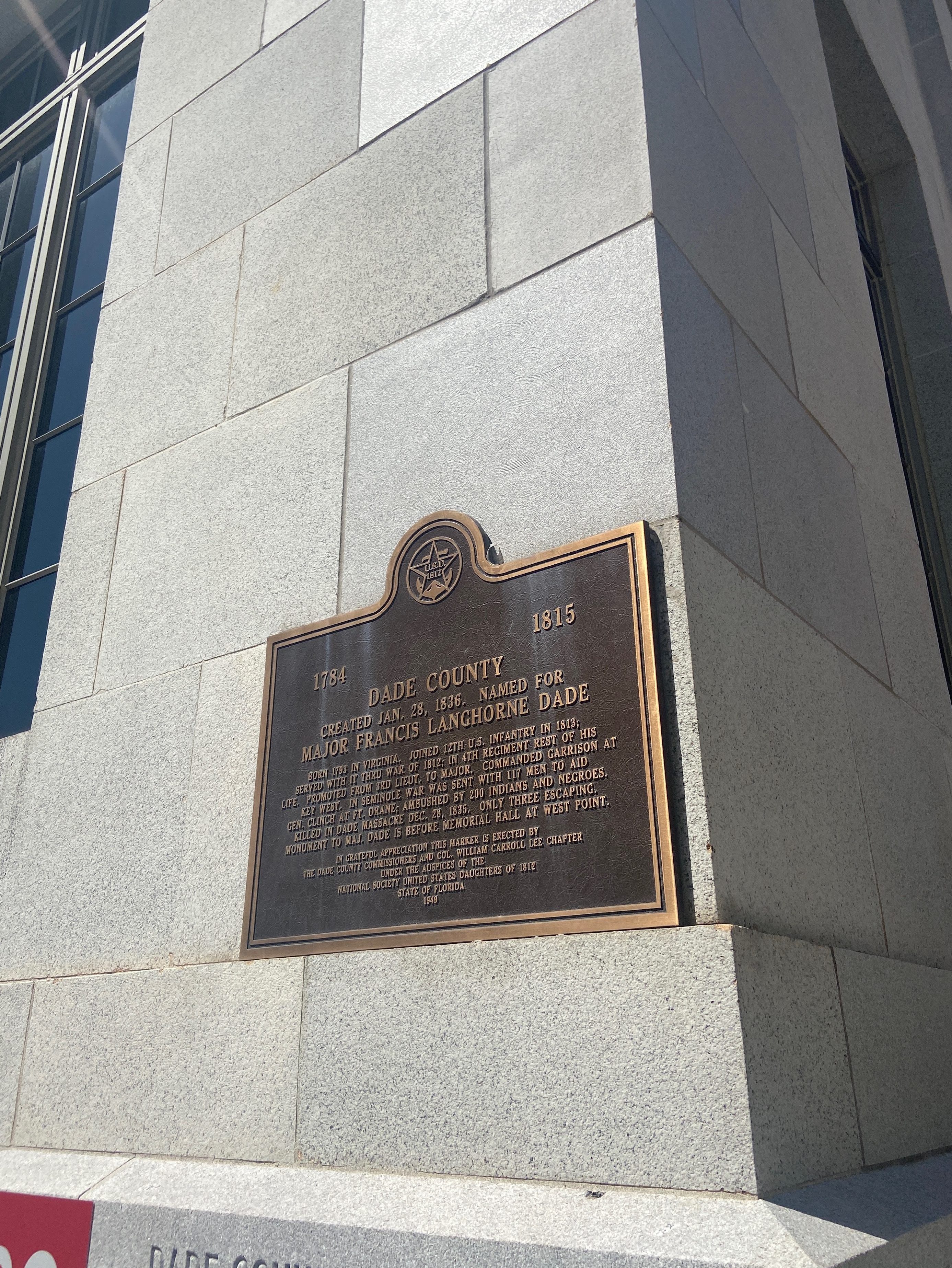
Mae Camacho is a Biological sciences student at FIU, focused on both biology and graphic design. She plans on mixing the two and pursuing her passion for art in illustration by finding her niche within the graphic design business after graduation. She also loves to write, both creatively and technically; the process is another means of expressing herself that she hopes to also tie into her future career. On her free time, she participates in the GLADES club at FIU, attending events such as clean-ups and hikes, and cultivates an interest in conservation sciences. Hikes, traveling, and world-building art take up most of her attention.
Deering Estate as Text
“The Land We Live On”
By Mae Camacho of FIU at the Deering Estate, 28, January 2022

Miami seems to have an awful reputation with its construction projects. Several focal points in the city with histories of delays, poor working conditions, employee deaths, resident deaths, and general safety violations or inconveniencing of the public. Just last year, a residential building made city-goers tense with anticipation when it collapsed one night without warning. No one knew if their building had the same safety violations, no one knew if their homes would be subject to the same tragedy. The Deering Estate is no stranger to this curse. Standing on the bank of the boat basin, it was chilling to learn that 4 of the Afro-Bahamians that worked to dredge a canal for Charles Deering died while working with unpredictable dynamite just a couple yards from where we were standing and hearing the story.
It wasn’t a time where labor union for these Bahamians to rally under could form. There was no mass outrage or call for better working conditions.
When one stands in the middle of downtown Miami, they see tall, mind-blowing skyscrapers, insane architecture, and colorful, Miami-branding lights. Few have the mind to look past it all and wonder about the land’s past. When one visits the Deering estate, they learn all about the main cottage’s past as an inn, they visit the old prohibition-style cellar, or they walk the estate’s beautiful gardens. The estate has so much ground with a type of limestone terrain that one would never imagine the neighborhoods of Biscayne Bay to be built on. But the Afro-Bahamian workers made it happen. I wonder if enough people walk past the breath-taking sights of the estate acknowledging that those Bahamians made it possible (without a professor-guide to inform them). We learned that although the property lacked a lighthouse, Charles Deering installed light posts on the East side of his Stone House that acted as light sources for incoming boats. I wonder if he looked out the East side, past his French doors and over the lit canal of his boat basin, and acknowledged all the sacrifice his land was built on.
Even before the time of the estate’s construction, before the Bahamians worked the land, the native Tequesta people called it home. We know little of their people’s culture, as they essentially lived and disappeared without a trace. Or more so, without being preserved. As proof of their existence, small shell pieces liter the ground in a midden on the property, perfectly shaped to fit in someone’s hand and be used as tools. These were most likely the tools the Tequesta used to drill or carry out construction projects, under their own command and working conditions.
A burial mound also exists on the property, one of two sites still preserved. Two of the 12-18 skulls had apparently been taken, and I can’t help but wish that whoever has them now knows of the type of treasure they possess; besides the disrespect of the actual desecration, to hold the remains of Miami’s original ancestors over their own land is considered, to an appreciative few, a huge spiritual experience. The Tequesta breathed and lived and started some of the first civilizations that Miami would be built atop. When walking past skyscrapers and pretty beachside homes, one should know enough of these native people to acknowledge their role in and importance to Miami history, not just of commanding men like Ponce de Leon and Charles Deering. Men at the helm who can take credit and be named for treasures like the Deering estate, but who I don’t primarily think about while walking the grounds. The hardwood hammocks and mangrove forests that make up the beautiful terrain of Biscayne Bay will always first belong to the Tequesta.
Viscaya as Text
“Art of Balance”

Symmetry is critical to a ship’s functioning. Maybe not to the modern yacht, but definitely to the sailing ships present during Viscaya’s 1916 opening. The same ships used to transport alcohol during the prohibition era to James Deering’s vacation home relied on a symmetrical hull to be able to carry a heavier cargo. This is opposed to an asymmetrical hull, which would require less power to move less of a load. This symmetry, as practical and reliable as it was, also served the winter estate in its aesthetics. It carries from the stone barge out front to the mansion’s East entrance, where a sailing ship hangs from the ceiling framed and surrounded by the most symmetrical shape in existence: a circle, patterned onto the marble floor by diamonds and arches.
In this walk from outside to inside, you’re greeted by arms created by one path curving from the boat landing and the tea house, and then beckoned closer inside by the uniformity of Deering’s design. I felt a sense of unwavering balance taking this walk, letting the symmetry of the home’s architecture take the wheel on my mental state, shifting a recovery from Miami traffic and at-home chaos to complete peace of mind. It pays to be surrounded by art that can influence emotions and inspire peace in the same way the ocean’s gently lulling waves can stabilize a ship and put its sailors to sleep. James Deering definitely knew what he was doing.
The ship, seemingly the house’s mascot, can be seen in most parts of the house, including the breakfast room on the second floor. The wall here is painted with a panoramic view of the ocean, where detailed sailing ships sit in the waters next to the most ornate fireplace I’d ever seen: a clear focal point of the room. The house is filled with several rooms like this, where one statement piece takes up most of the attention and lures the visitor further into the show of overkill extravagance. And while symmetry can be found in the smallest painted details, the whole home manifests a strong equilibrium as the courtyard sets the surrounding rooms into a perfect square, as the deep gardens set the home at the base of an inverted pyramid, and as a visitor of the home looks out and over to the garden mound, settled into their own perfect space in the house. This may be the most desired and alluring effect for a vacation home, and Deering close to perfected it. The symmetry of the home makes the whole property one of the strongest statement pieces for Miami’s art scene in Coconut Grove. It pulls everything together and pulls its visitors further into the depths of its hull, where one can walk in with a heavy load and a thousand worries and yet still find a resonating peace within its symmetry.
Downtown Miami as Text
“Knuckles on the Metro”

My day in downtown Miami started with my brass knuckles out on the metro. I wanted to make sure I followed the advice of several people that warned me about taking the train alone as a young woman, but my trip there was pretty uneventful. Mornings on the metro seemed pretty monotonous, just men and women trying to get to work without mishap. But city life hadn’t really started at that time.
More of that expected city chaos came to life right in government center, as men and women rushed to get to work on time with their heads down, again avoiding some type of mishap. We learned about the sculpture in the middle of a plaza, a bowl of oranges built to look like the bowl had just smashed onto the ground. It symbolizes the chaos of Miami’s urban life and growth. At this point, I should’ve gotten the hint.
Downtown Miami is like when landlords try to paint over hatches that shouldn’t be opened, or like when they spray lysol over toxic mold. I’ve personally never tried to solve a problem by implementing a solution that would cause more problems, but this is how the city of Miami seems to be dealing with their homeless population. Hostile architecture like unnecessary divisions on benches and ledges, spikes where it would be convenient to sit, and even a key pad on a McDonald’s bathroom door, only make the city seem like one heavily guarded entity. These features exist to drive unhoused men and women away from areas where they could rest and just exist, diverting the problem where there is yet to be a logical solution. These features can’t scarecrow an entire population away, there have to be spaces or help and opportunities that the city can’t seem to come up with. Or more so, that they don’t seem willing to fund. This is just one physical element that makes downtown so hostile. The area is also un-walkable, made so partly by several unfinished construction projects that sometimes divert foot traffic directly onto the roads. There is danger everywhere, even to manatees in the bay, where boaters have to look for a small sign on a pillar facing the opposite direction letting them know to drive slow. Many boaters steer drunk. Our manatee populations are doomed.
Even metaphysically, downtown screams hostility. Above the courthouse steps stands a statue of Henry Flagler, who essentially started the city’s segregation streak by refusing to house his colored workers. This is because he knew his target audience (white landholders) wouldn’t want to neighbor them. On the outside of the courthouse, a plaque details the story of the ambush and death of Major Francis Dade by the Seminoles, who were holding and defending their ground as the U.S. government compromised their treaty and invaded Seminole territory. The plaque calls this group “Indians and Negros”. It still stands, incredibly biased in its description, and undisturbed in 2022. Decorated by a symbol of injustice and a symbol of clear bias, this courthouse could not appear more hostile to any minority promised a fair trial inside.
The city of Miami should know that aesthetics can’t cover for innate hostility. I made my way to the metro station with my head down, because I was told not to answer anyone that might talk to me as I walked alone. On the ride back, I watched a homeless man, clearly mentally ill, harass and threaten a woman for 15 minutes. All avoided the mishap, too tired from their days at work. I didn’t do anything about him, knowing the city wouldn’t do anything for him, knowing the woman was probably used to it, and thinking I should just hold my brass knuckles tighter.
South Beach as Text
“Famous Visitors and Famously Visited”

There isn’t much to say about South Beach that couldn’t be expressed better by showing you. And realistically, that’s what the area is for. Celebrities come, paparazzi follow, influencers can be seen almost everywhere, staging their own photoshoots. South Beach seems to be less for locals now and more for all to come and enjoy while goggling at the characteristically original Art Deco architecture.
The area, socially discovered and shoved into the spotlight by Versace himself, is known for its famous visitors and unique sky-line. The Art Deco on Ocean Drive is original in the way some buildings mimic what you see across the street. Porthole impressions work their way onto the buildings, mimicking the cruise ships that ride the horizon almost every day at Miami Beach. The colors, such as on the Colony hotel, either mimic ocean blues or compliment them in a variety of pastels and bold, loud geometric outlines. This Art Deco phenomenon sweeps most of Ocean Drive, where the buildings are kept to within 3 stories, effectively keeping visitors’ eyes down and out of the ruthless sun.
South Beach is also famously characterized and given attention to for its acceptance and contagious free spirit. Before it was socially acceptable, women had more skin exposed here than in most of the country. The Palace, a club well known for its drag queen shows and lines out the door, was opened in 1988, a time when drag queen shows were still being kept niche by strong social expectations and discrimination. Miami Beach is seemingly always one step ahead of the rest of the country, which is partially what began its reputation as a celebrity trap. It’s been able to stay so progressive number one, because of the isolation and lack of connection Miami had to the rest of the country while it was developing, and secondly, because as the OG socialite attracted crowds, Versace attracted those that already fit into his lifestyle.
South Beach stands as, and will always represent, a place of exceptionality and unwavering individuality. As it continues to stand (in its own short and colorful stature), I hope that the area never comes to be tame or any less bold than I have seen it be.

Mae Camacho
Force me to escape my comfort zone by funding this trip! I’ll use any funds to fuel new foods and experiences! THANKS!
$1.00